Neurobiology is without a doubt, one of the most fascinating and complex domains of biological studies! For those of you who may be interested in specializing in neurology or neurosurgery, this should get you excited!
Though you might think that, given this its name, the branch of biology solely deals with studying the brain — while true, this field also covers many other topics such as biochemistry, immunology, etc.!
After going through this chapter overview, you’ll be equipped with basic knowledge about the brain, its organization and function, and much more! Let’s get into it!
Neurobiology on the MCAT: What You Need to Know
Topics on neurobiology will be tested on the Psych/Soc section of the MCAT and can appear both as passage based and fundamental discrete questions.
Try to expect around 4-6 questions that can come up covering neurobiology! Additionally, also note that you’ll probably be tested on similar concepts in the Bio/Biochem section, as these also cover similar topics!
Introductory psychology accounts for 65% of the content covered in the Psychological, Social, and Biological Foundations of Behavior, while introductory sociology covers about 30 of the content.
Important Sub-Topics: Neurobiology
An important thing to note is that neurobiology, as tested in the Psych/Soc section, will probably focus more on the brain specifically. These may include the different brain regions, the function associated with each brain region, etc.
Neurobiology, as tested in the Bio/Biochem section, will probably have an emphasis on the nervous system as a whole and will most likely test the topic from a more physiological standpoint!
1. Anatomy and Divisions of the Nervous System
When looking at the nervous system as a whole, we can break it down into 2 main divisions: the central nervous system (CNS), which contains the brain and spinal cord, and the peripheral nervous system (PNS), which includes the peripheral nerves outside of the brain and spinal cord.
The PNS can be further subdivided into the somatic division, which initiates voluntary controlled action like skeletal muscle contraction, and the autonomic division, which controls unconscious, involuntary action like heart rate and sweating!
Finally, the autonomic division can be divided into the sympathetic division, which corresponds to your “fight or flight” response in order to counter stressful stimuli and the parasympathetic division, which is your “rest and digest” state working to conserve energy!
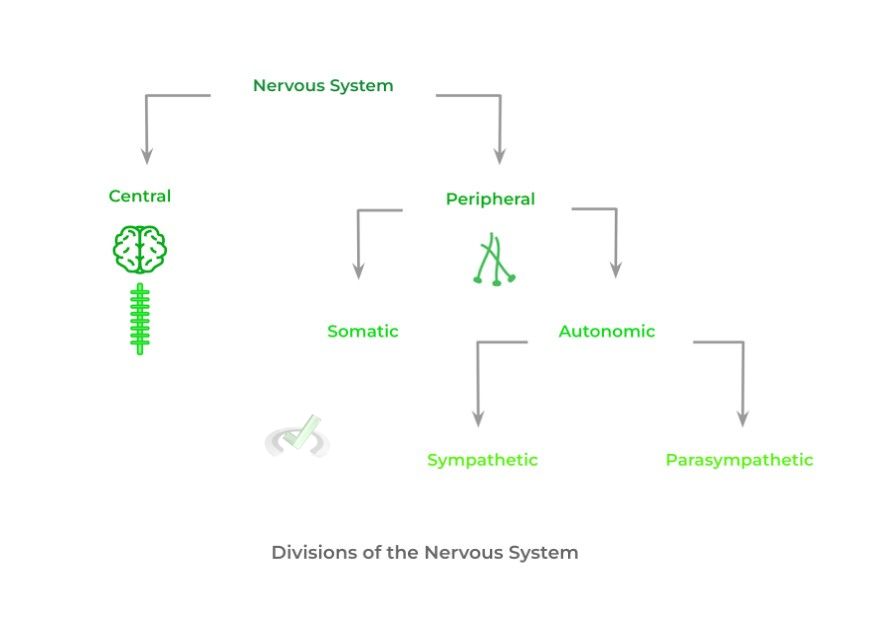
Full Study Notes : Anatomy and Divisions of the Nervous System
For more in-depth content review on the anatomy and divisions of the nervous system, check out these detailed lesson notes created by top MCAT scorers.
2. Anatomy of the Brain: Major Regions and Lobes
Though still much is not known about the brain, with more research to come, neuroscientists have been able to make general functional associations within the various brain regions.
To start off, the brain is divided into 3 main regions: the forebrain (prosencephalon), midbrain (mesencephalon), and the hindbrain (rhombencephalon). It’s difficult to visualize all these components all at once, so let’s look at these components as diagrammed below:
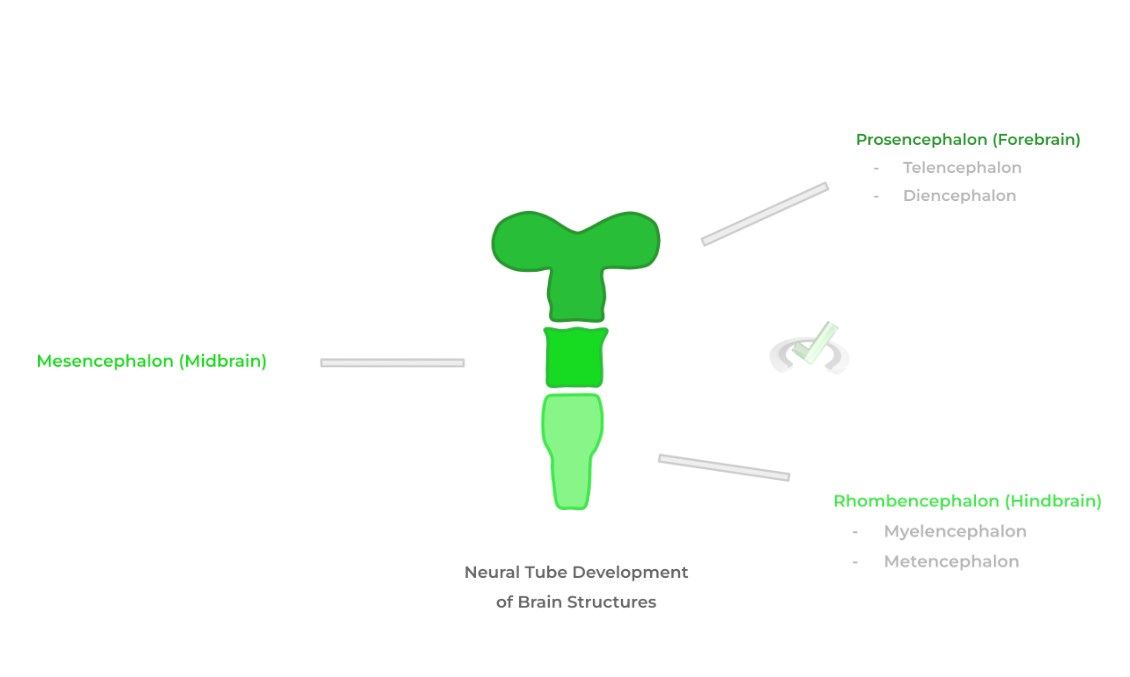
Don’t worry if this doesn’t look like a brain yet — in about a month, it will be! We wanted to present it like this because it better differentiates the 3 main divisions of the brain!
As shown above, the 3 main portions also have some further subdivisions. In addition, we can attribute some generalized main functions for each of the 3 divisions of the brain as we detail below.
A. Rhombencephalon (Hindbrain)
Includes the myelencephalon (develops into the medulla oblongata) and the metencephalon (develops into the pons and cerebellum)!
Primarily controls function involved in surviving and controlling smooth motor movement and coordination!
B. Mesencephalon (Midbrain)
Includes the superior and inferior colliculus (plu. colliculi) and is primarily involved in unconscious reaction to sensory stimuli!
C. Prosencephalon (Forebrain)
Includes the telencephalon (develops into cerebral cortex) and diencephalon (develops in the limbic system, etc.)
Primarily controls higher executive function and cognition of individuals (i.e. decision making, language comprehension, etc.)
We’ll get into all the other structures and functions of the above mentioned structures in the next section, but we’ll briefly highlight the cerebral cortex specifically as it’s important to our discussion of the brain lobes. Look at the main division shown below!
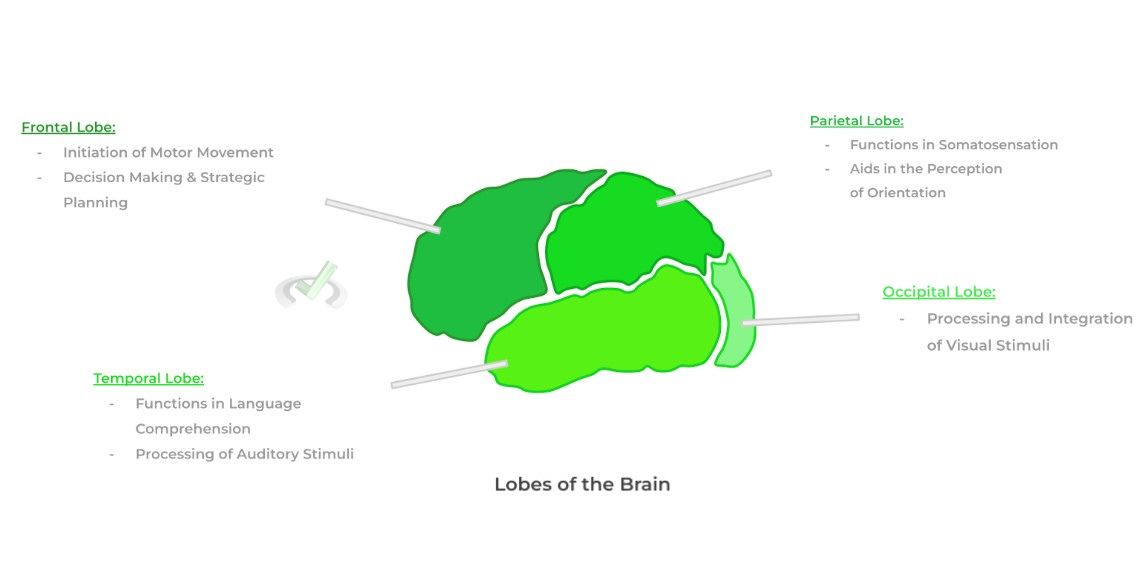
The cerebral cortex is the outermost neural tissue that covers the forebrain and is the main portion of the forebrain that is involved in higher executive function and cognition!
This is seen by the wide variety of functions in the 4 brain lobes of the cerebral cortex: from the processing of sensory information to the initiation of motor movement, the cerebral cortex allows for all this higher-level cognition!
Additionally, another important aspect of the cerebral cortex is that there are 2 hemispheres, aptly named the left and right hemispheres. These 2 hemispheres are connected and relay information to each other through a set of neural tissue called the corpus callosum.
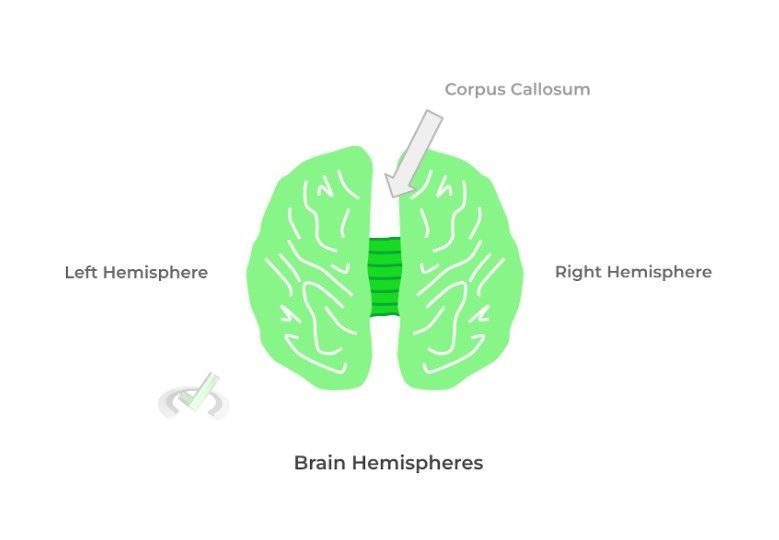
The brain hemispheres and the corpus callosum are responsible for what’s called contralateral control and sensation! This means that sensation of sensory stimuli and initiation of motor action on one side of the body will occur on the opposite brain hemisphere!
In other words, sensory stimuli and motor action on the left side of the body will be perceived and initiated by the right brain hemisphere (and vice versa!) There are some exceptions, as we’ll see in visual perception, but generally, this relationship holds true!
Full Study Notes : Anatomy of the Brain: Major Regions/Lobes
For more in-depth content review on the different brain regions and lobes, check out these detailed lesson notes created by top MCAT scorers.
3. Anatomy of the Brain: Major Brain Structures
You can take a semester-long course about neuroanatomy and you’d still be scratching the surface of the amazing biology of the brain! However, for the scope of the MCAT, we’ll introduce you to the basic, major brain structures to be familiar with!
We’ll divide and cover the outlined brain structures into 2 main sections: the major structures of the forebrain and the major structures of the brainstem (which includes some structures in the midbrain and hindbrain).A. Structures of the Forebrain
The cerebral cortex is a major forebrain structure responsible for our higher level cognition! Note also that the cerebral cortex is called the neocortex, alluding to the fact that it’s the most recently evolved brain structure!
The limbic system is an important set of structures in the forebrain responsible for emotional processing, memory formation, and sensory relaying, found just under the cerebral cortex — look at some of the main structures below!
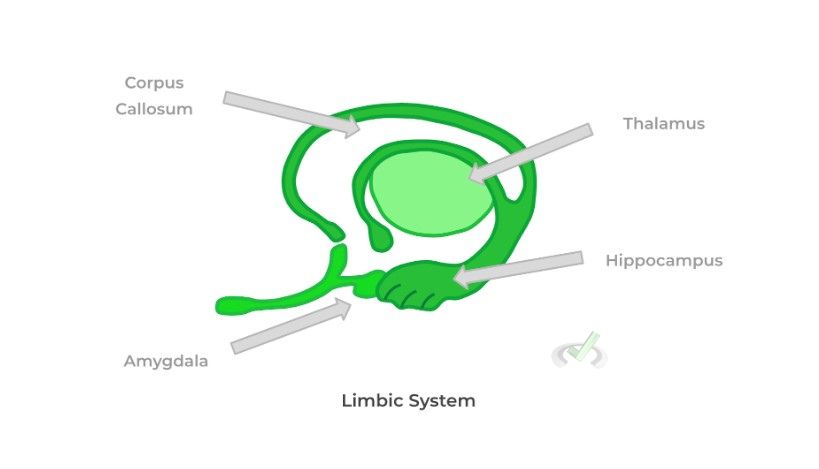
The amygdala allows for our emotional recognition and projection, specifically in fear and anger! The hippocampus, which is responsible for memory formation and consolidation.
These 2 structures have various connections and constant communication; in fact, the interaction between the 2 structures allows for an emotional association to be formed with memories!
The thalamus is the central, sensory relay station — it takes incoming sensory stimuli and allows for the stimuli to be sent to the appropriate brain region to be perceived! Think of it like NYC’s main central station!
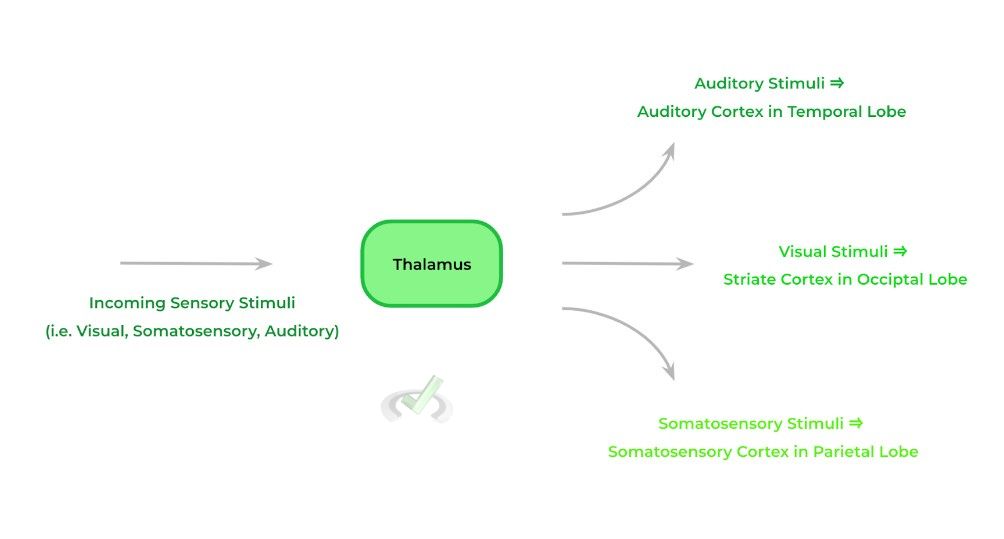
The final forebrain structure we’ll cover is the hypothalamus, which is the main neuroendocrine interface! Aside from being a smart person word, it simply highlights the importance of the hypothalamus in physiological regulation via neural and endocrine functions!
The hypothalamus is crucial for maintaining homeostasis and equilibrium within the body. It can correct this imbalance by the release of hormones or stimulation of nerve fibers!

As shown above, the hypothalamus can regulate bodily function via the release of hormones to the pituitary gland, which then releases more hormones! Additionally, the hypothalamus can also regulate physiological function via neural activation!
B. Structures of the Brainstem
The brainstem is the collection of structures containing the midbrain, pons, and medulla oblongata and connects the cerebral cortex to the spinal cord as depicted below!
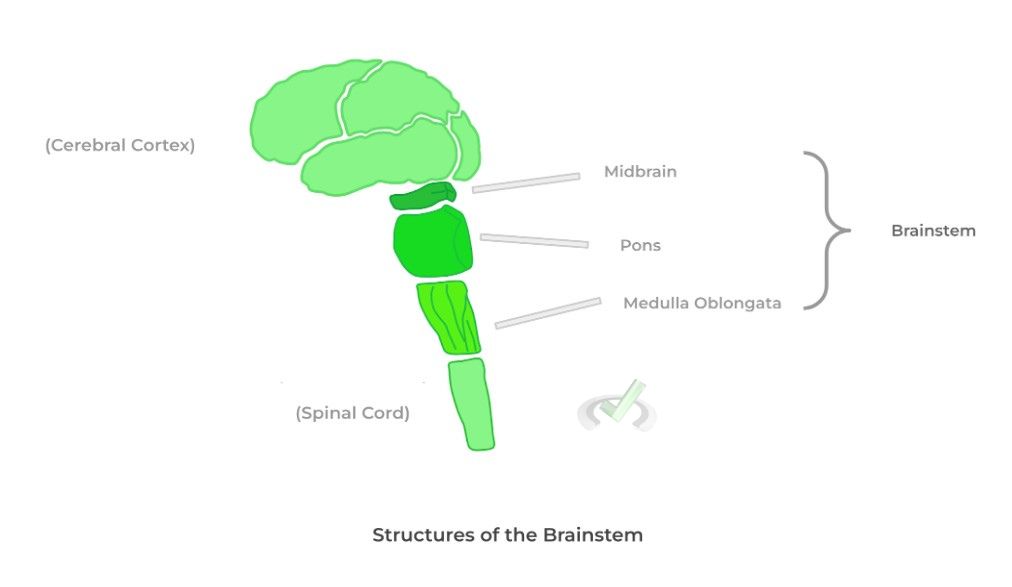
The brainstem is primarily responsible for regulating our basic survival functions such as breathing and heart rate, blood pressure and volume, etc. This is especially true for the medulla oblongata which has specific respiratory and heart rate centers to regulate this physiological response.
Full Study Notes : Anatomy of the Brain: Major Structures
For more in-depth content review on the major brain structures, check out these detailed lesson notes created by top MCAT scorers.
4. Neuronal Communication and Behavior
Understanding neuron communication sets the foundation for how it influences our behavior! These include some of the primary characteristics and functions of the various neurotransmitters present within the nervous system.
In this context, we’ll have a specific focus on neurotransmitters as our study of action potentials is more widely covered in our “Nervous Systems on the MCAT!” overview. However, we’ll still give you the basic gist of neuron communication.
In its simplest form, neurons communicate with one another via special chemical messengers called neurotransmitters. Neurotransmitters are released by one neuron end (i.e. presynaptic terminal) and bind to receptors on another neuron (i.e. postsynaptic terminal).
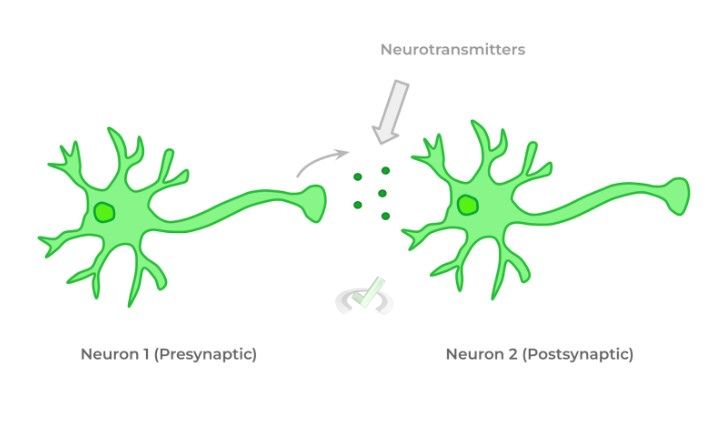
The type of effect that’ll occur upon neurotransmitter binding depends both on the neurotransmitter itself as well as the type of receptor the neurotransmitter binds to.
Though neurotransmitters can have a wide variety of effects, the table below outlines some of the more well-known neurotransmitters and some of their general effects and functions within the nervous system:

While of course this is just a brief generalization, the above NTs and their functions will suffice for your preparation on the MCAT.
Full Study Notes : Neuronal Communication and Behavior
For more in-depth content review on neuronal communications and how the main neurotransmitters affect behaviors, check out these detailed lesson notes created by top MCAT scorers.
5. Genetic and Environmental Influence on Behavior
There’s been a wide-held debate in scientific research in determining whether individuals’ behavior is a consequence of genetic inheritance or environmental influence, often called the nature v.s. nurture debate.
In reality, the answer lies somewhere in between: there are many research studies showing support for both! For instance, the risk of developing an addictive behavior to substances such as alcohol is almost 50% determined by genetics!
However, studies also highlight the importance of the socioeconomic impacts of developing alcohol addiction. For instance, the individual would need to be exposed to alcohol during their daily experience in order to develop that addiction as well!

Click and give this article a read to learn more about the genetics and external factors influencing behavior as well as how we can study them!
Full Study Notes : Genetic and Environmental Influence on Behavior
For more in-depth content review on neuronal communications and how the main neurotransmitters affect behaviors, check out these detailed lesson notes created by top MCAT scorers.
6. Methods for Brain Imaging and Studies
In order for researchers and physicians to study and diagnose the brain for certain diseases, there are a variety of brain imaging techniques that can be used! We’ll cover some of the main ones that maybe you’ve undergone at some point in life!
When studying the various brain imaging techniques, we’ll give you the bare minimum in regard to the rationale behind each of the techniques. It’s more important to understand when it’s more beneficial to use one technique over the other.
This is especially true for what type of information you want to obtain: spatial information (those dealing primarily with structural details) or temporal information (those dealing with measuring brain activity over time).
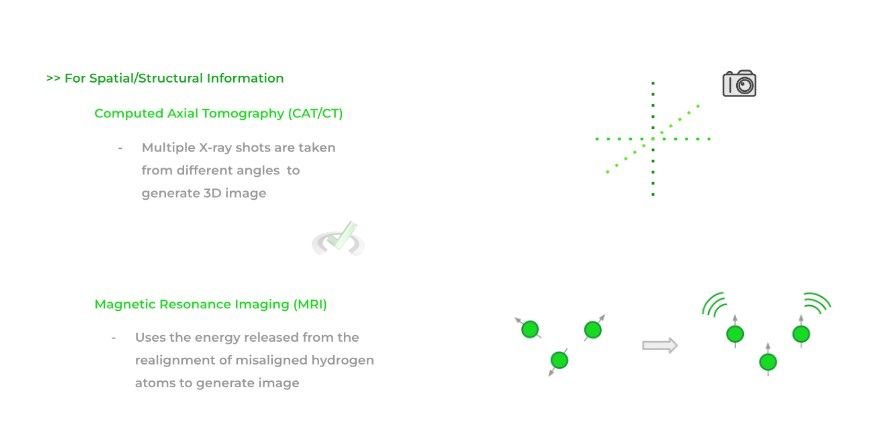
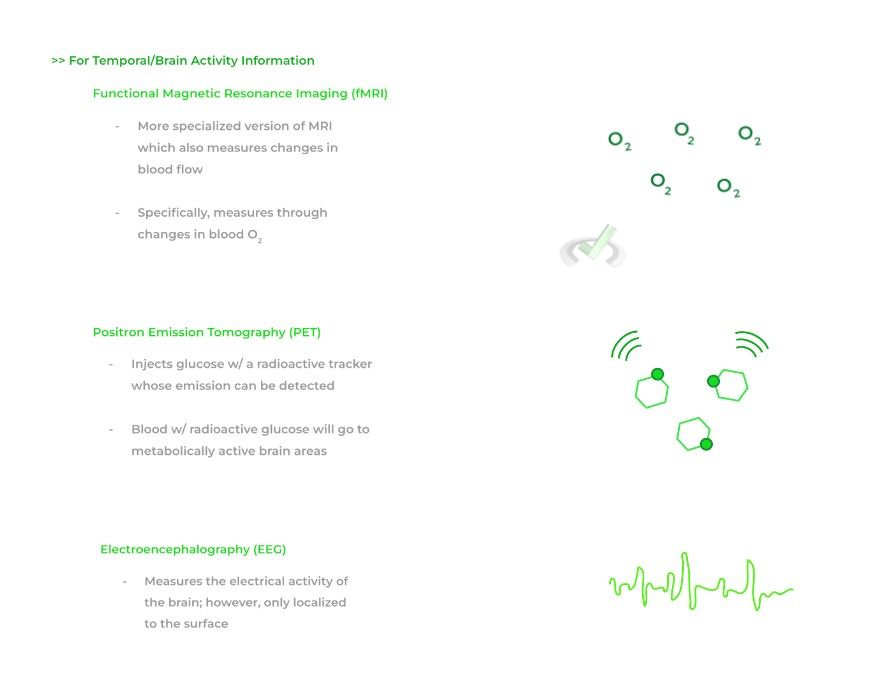
As we want to reemphasize, try not to get wrapped up in all the complexities of the techniques! Instead, focus on the basics and then emphasize when it’s appropriate to use a certain technique.
Full Study Notes : Methods for Brain Imaging/Studies
For more in-depth content review on the different brain imaging techniques, check out these detailed lesson notes created by top MCAT scorers.
Important Definitions and Key Terms
Below are some high yield definitions and key terms to refer to when reviewing concepts and ideas about neurobiology!
Term | Definition |
|---|---|
Central Nervous System | Division of the nervous system which includes the brain and spinal cord |
Peripheral Nervous System | Division of the nervous system which includes nerves outside the brain and spinal cord |
Forebrain (Prosencephalon) | Region of the brain whose structures involved in higher level thinking, cognition, and executive function |
Midbrain (Mesencephalon) | Region of the brain whose structures are involved in unconscious reflex to visual and auditory stimuli |
Hindbrain (Rhombencephalon) | Region of the brain whose structures are involved in the processes which maintain basic survival function |
Frontal Lobe |
Lobe of the cerebral cortex involved in initiating motor functions and higher level strategic planning |
Parietal Lobe |
Lobe of the cerebral cortex involved in somatosensation and orientation |
Temporal Lobe |
Lobe of the cerebral cortex involved in perception of auditory stimulus and language comprehension |
Occipital Lobe |
Lobe of the cerebral cortex involved perception of visual stimuli |
Corpus Callosum |
Collection of neural tissue which connects the 2 brain hemispheres and allows for their intercommunication |
Limbic System |
Set of forebrain structures involved in memory consolidation, emotional recognition, and sensory relaying |
Amygdala |
Limbic structure which is involved in emotional recognition and projection, especially in fear and anger |
Hippocampus |
Limbic structure which is involved in memory consolidation |
Thalamus |
Limbic structure which is involved in the relaying incoming sensory stimuli to the appropriate brain regions to be perceived |
Hypothalamus |
Structure which acts on the main neuroendocrine interface and works to maintain homeostasis of the body |
Medulla Oblongata |
Hindbrain (& brainstem) structure which functions in the regulating our major autonomic processes such as breathing and heart rate |
Neurotransmitters |
The main chemical messengers utilized within the brain for neurons to communicate with one another |
Computed Axial Tomography (CT/CAT) |
A type of brain imaging technique where X-rays are taken from many different angle to form a 3D image |
Magnetic Resonance Imaging (MRI) |
A type of brain imaging technique where an image is formed by the energy released from the realignment of misaligned hydrogen atoms |
Functional Magnetic Resonance Imaging (fMRI) |
A type of brain imaging technique which is a specialized version of MRI but also measures changes in blood, specifically in changes in blood O2 |
Positron Emission Tomography (PET) |
A type of brain imaging technique where glucose molecule with radioactive trackers are injected into the bloodstream; their emission can be measured and give information on metabolically active brain areas |
Electroencephalography |
A type of brain imaging technique which measures the electrical activity of the brain |
Additional FAQs - Neurobiology on the MCAT
A. Is Brain Anatomy on the MCAT?
B. Is Neuroscience an Interdisciplinary Field – MCAT?
This is why in our articles, we always have a bridge section in order to highlight the interdisciplinary nature of many biological fields!
C. Does Neuroscience Help with the MCAT?
D. What Makes Up the Brainstem – MCAT?
E. What Are Astrocytes – MCAT?
F. What is the Midbrain – MCAT?
Additional Reading Links – Study Notes for Neurobiology on the MCAT
Additional Reading:
- Identity and Personality on the MCAT
- Language Development on the MCAT
- Learning and Memory on the MCAT
- Motivation and Emotion on the MCAT
- Cognition and Consciousness on the MCAT
- Psychological Disorders on the MCAT
- Sensation and Perception on the MCAT
- Social Interaction on the MCAT
- Social Processes and Behavior on the MCAT
- Social Structure and Stratification on the MCAT
- Social Thinking and Attitudes on the MCAT







 To help you achieve your goal MCAT score, we take turns hosting these
To help you achieve your goal MCAT score, we take turns hosting these 





















 reviews on TrustPilot
reviews on TrustPilot